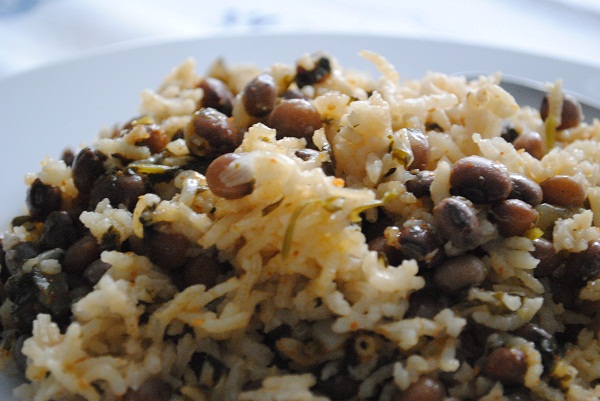Arroz con Gandules | Puerto Rican Rice with Pigeon Peas

I grew up eating arroz con gandules, that quintessential rice dish that every Puerto Rican family has their own version of making. Most of the time it was made con pollo, or with chicken, but it was also made vegetarian, too. My mom is an American-born Puerto Rican whose family was very traditional in their foodways so this dish was always at the table of family gatherings.
I remember my great aunt, Virgen (whose name was pronounced in the dialect as “Beehin”) used to make it every single time we went to her house to visit. As soon as she heard we were on our way, she would whip it up quickly and serve it to us with a coke (and I had already usually just eaten a full meal of Sicilian meatballs and pasta at my Sicilian grandparents’ house just before visiting).
I always wondered how she was able to make such a traditional dish so quickly. I figured it was because it was something she obviously memorized and knew how to do.
Little did I realize until later on in life when I began making traditional dishes like this from scratch, that the Goya product line helped to make most dishes so much easier for all of the Puerto Rican women in my family. Except maybe my abuelita (grandmother) who was known for her delicious culinary adventures, mostly made from scratch.
And that’s how I wanted to make everything, including the sofrito, or the base of so many Puerto Rican dishes. It’s a mixture made up of fragrant herbs and produce like cilantro, onion, green pepper and cubanelle peppers. Whenever I smell this base, I smell la isla– the island…
 Cubanelle Peppers
Cubanelle Peppers
Then there comes the annatto oil, or achiote. Read more about how to make that here.
Simply cook the dish following the steps in the recipe, whether you have the annatto oil or not.
As I said, I don’t use a lot of annatto in my oil, so the rice is not a deep orange, but a darker hue than plain white.
And as I mentioned recently on the MHK Facebook page, add a splash of vinegar or lemon juice to the rice to make the rice a bit fluffy.
Arroz con Gandules (Puerto Rican Rice with Pigeon Peas
If you decide to use fresh pigeon peas (found at most Latin grocers) instead of the canned ones, soak them overnight and cook thoroughly ahead of time. Also, prepare the sofrito and the annatto oil before beginning the recipe.
Serves 4
Ingredients
- 1 ½ cups medium grain rice
- 2 tablespoons annatto olive oil
- 1/3 cup sofrito
- 1 ½ cups pigeon peas (also known as gandules)- found at most Latin markets
- 2 teaspoons salt
- 1 tablespoon ground annatto seeds
- 1 tablespoon ground cumin
- Water to cover the rice according to specific package instructions
- Freshly chopped cilantro, to garnish
Directions
- In a deep and wide sauté pan or large Dutch oven, heat the prepared annatto oil gently.
- Add the rice and allow it to brown slightly. Add the sofrito, pigeon peas, salt, ground annatto and cumin . Mix well into the rice. Add the water.
- Bring the rice to a boil and let cook for about five minutes then reduce the heat. (Add a splash of vinegar now, if using)
- Cover securely and cook on low for about 20 minutes, or until rice is fluffy and completely cooked.
- Remove the pan from heat and remove the cover of the pan to release some of the steam.
- Serve with freshly chopped cilantro on top.











Good instruction for the novice in Puerto Rican cuisine! If you want to keep annat oil on hand, simply warm a good amount of olive oil in a saucepan on low medium heat, not allowing it to boil, just get a bit hot, add the annato seeds and let it sit, stirring occasionally, until the oil is the dark orange color. Set aside to cool, remove seeds an pour into an oil bottle and keep in the refrigerator. But that is for those who cook all the time. You don’t want the oil to get too hot because it will spew orange oil all over and that stuff just can’t be gotten off once it stains!!!
Do you happen to know what the annatto is called in Filipino markets? I live abroad and there are no Latin shops here but there are Thai and Filipino ones so I’m hoping to come across it in this way!
@Stacey- I believe they are also called ‘annatto’ in Filipino markets, at least from what I have seen. Good luck finding them, too 🙂
Jazak Allahu khair!
Sofrito has bacon bites tho